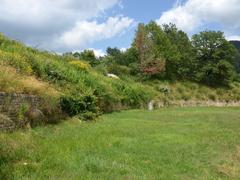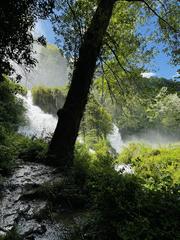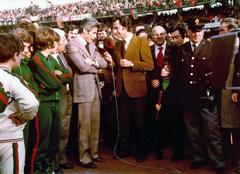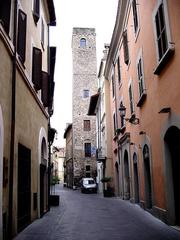
Terni Cathedral Visiting Hours, Tickets, and Historical Significance Guide
Date: 04/07/2025
Introduction
Nestled in the heart of Umbria, Italy, Terni Cathedral—officially known as the Cathedral of Santa Maria Assunta—stands as one of the region’s most enduring symbols of faith, history, and community. With origins stretching back to the 4th–6th centuries CE, the cathedral is not only a prominent architectural landmark but a living center of spiritual and civic life. Over the centuries, it evolved from a modest early Christian church into a grand complex blending Romanesque, Renaissance, and Baroque styles. Today, Terni Cathedral is revered for its religious relics, including the Precious Blood of Jesus, and its close association with local saints such as Saint Valentine and Domnina of Terni. This comprehensive guide explores the cathedral’s rich history, architectural highlights, and practical information—covering visiting hours, tickets, accessibility, and tips for making the most of your experience in Terni (Wikipedia: Terni; Diocesi di Terni; New Daily Compass).
Table of Contents
- Origins and Early Development
- Architectural Evolution
- Religious and Cultural Significance
- Notable Events and Figures
- Artistic and Architectural Highlights
- Visitor Information: Visiting Hours, Tickets, Accessibility
- Nearby Attractions and Travel Tips
- Cultural and Religious Significance
- Visiting Highlights: Exterior, Interior, and Crypt
- FAQ
- Visuals and Media
- Conclusion
- References
Origins and Early Development
Terni Cathedral’s history is closely linked with the Christianization of ancient Interamna Nahars (modern Terni). While the exact date of its foundation is debated, evidence suggests that the first church on the site appeared between the 4th and 6th centuries CE, likely supplanting a pagan Roman structure. The cathedral served as a focal point for the burgeoning Christian community and was the seat of the local bishopric (Wikipedia: Terni).
Architectural Evolution
Medieval Transformations
Throughout the Middle Ages, the cathedral underwent significant expansion. Romanesque features such as thick walls, rounded arches, and the construction of a bell tower were added as Terni’s prominence grew. The church became an anchor for both spiritual practice and local identity.
Renaissance and Baroque Rebuilding
A major transformation occurred in the 16th and 17th centuries, when the cathedral was rebuilt in the Baroque style. The new façade, ornate stuccowork, frescoes, and the theatrical reordering of the interior reflected the era’s artistic and devotional trends (Wikipedia: Terni).
Modern Restorations
After suffering wartime damage during World War II, the cathedral underwent extensive restoration, preserving elements of its Baroque grandeur while safeguarding remnants of earlier periods (Wikipedia: Terni).
Religious and Cultural Significance
Episcopal Seat and Liturgical Center
As the spiritual heart of Terni, the cathedral is the seat of the Diocese of Terni-Narni-Amelia. It hosts major liturgies, ordinations, and community gatherings, reflecting centuries of continuous use and devotion.
The Relic of the Precious Blood
One of Terni Cathedral’s most significant treasures is the relic of the Precious Blood of Jesus—a pectoral cross containing a splinter of the True Cross and a vial of what is venerated as Christ’s blood, donated by Cardinal Rapaccioli in 1651. The relic is the center of annual religious celebrations, especially in September (New Daily Compass).
Role in Times of Crisis
The cathedral has served as a place of refuge and intercession during crises, such as the 1656 plague, when the community gathered for prayers and sought divine protection (New Daily Compass).
Notable Events and Figures
- Saint Valentine: Terni’s association with Saint Valentine, the city’s 3rd-century bishop and patron of lovers, is legendary, though his relics rest in the nearby Basilica di San Valentino.
- Cardinal Rapaccioli: His Baroque-era reforms and the donation of the Precious Blood relic raised the cathedral’s profile.
- Wartime Resilience: Despite severe WWII bombings, the cathedral’s restoration became a symbol of civic perseverance (Wikipedia: Terni).
Artistic and Architectural Highlights
- Façade and Portico: A Baroque façade with classical columns and marble statues.
- Nave and Altars: Blending Romanesque solidity with Baroque exuberance, the nave is lined with side chapels, ornate altars, and frescoes.
- Rose Window: The façade’s rose window fills the interior with colored light.
- Crypt: Houses relics of early Christian martyrs and Bishop Saint Anastasius, with glass flooring revealing ancient foundations (Diocesi di Terni).
- Frescoes and Paintings: Works by artists such as Livio Agresti and Francesco Romolo Cincinnatus.
Visitor Information: Visiting Hours, Tickets, and Accessibility
- Visiting Hours: Generally open daily from 8:00 AM to 7:00 PM. Hours may vary during religious holidays and special events. Confirm latest times via the Turismo Comune Terni website.
- Admission: Free entry; donations appreciated. Tickets may be required for guided tours or special exhibitions.
- Guided Tours: Available through the local tourism office and private guides; advance booking recommended.
- Accessibility: The main entrance and most interiors are wheelchair accessible. Some chapels and the crypt may have steps or uneven surfaces; no elevators are present.
- Facilities: Restrooms are available near the cathedral; accessibility assistance can be requested on site.
Nearby Attractions and Travel Tips
- Basilica di San Valentino: Shrine of Saint Valentine.
- Roman Amphitheatre: Ancient ruins close by.
- Palazzo Spada: Renaissance palace with art collections.
- Piazza Europa & Church of San Francesco: Key sites within walking distance.
- Travel Tips: Wear comfortable shoes for cobblestones, visit in spring or autumn, and check weather forecasts. Cafés and shops around Piazza Duomo offer local specialties.
Cultural and Religious Significance
Terni Cathedral is built atop ancient Roman remains, symbolizing the shift from paganism to Christianity (Religiana). The crypt preserves relics of Domnina of Terni and Sant’Anastasio, attracting pilgrims, especially on feast days like July 27. Artistic highlights include the cosmatesque floor, Renaissance tribune, and apse frescoes by Liborio Coccetti (Diocesi di Terni). Modern enhancements—such as bronze doors by Bruno Ceccobelli and new artwork by contemporary artists—reflect ongoing commitment to blending tradition with renewal.
The cathedral remains a vibrant center for religious life, hosting diocesan events, ordinations, and Marian pilgrimages. Its survival through wars and restorations mirrors Terni’s tenacity and community spirit (Diocesi di Terni).
Visiting Highlights: Exterior, Interior, and Crypt
- Approach: The cathedral’s imposing Baroque façade and portico with statues set the tone for visitors (Turismo Comune Terni).
- Interior: A harmonious blend of historical styles, with a vast nave, side chapels, and artistic treasures.
- Crypt: Glass floors reveal ancient burial sites, and relics of local saints are preserved here (Sharry Land).
FAQ
What are Terni Cathedral’s visiting hours?
Open daily, generally 8:00 AM–7:00 PM. Check Turismo Comune Terni for updates.
Is admission free?
Yes. Guided tours or exhibitions may require tickets.
Are guided tours available?
Yes, through local tourism offices and private guides.
Is the cathedral accessible?
Main entrance and most of the interior are accessible; some chapels and the crypt may not be.
Can I take photos?
Yes, but refrain from flash and respect ongoing services.
Visuals and Media
Alt tags included for SEO: “Terni Cathedral visiting hours,” “Terni Cathedral tickets,” “Terni historical sites.”
Conclusion
Terni Cathedral is more than a historical monument—it is a living testament to centuries of faith, art, and community resilience. Free and accessible, it welcomes all visitors to discover its treasures, participate in its living traditions, and explore the broader historical landscape of Terni. For the latest information on visiting hours, guided tours, and special events, consult official sources or download the Audiala app.
Key Milestones Table
| Period | Event/Development |
|---|---|
| 4th–6th centuries CE | Probable foundation of the first Christian church |
| 12th–13th centuries | Romanesque expansion and fortification |
| 16th–17th centuries | Baroque reconstruction and artistic enrichment |
| 1651 | Donation of the Precious Blood relic by Rapaccioli |
| 1943–1945 | WWII bombings; post-war restoration |
| Present | Ongoing religious, cultural, and community functions |
References
- Wikipedia: Terni
- Diocesi di Terni
- New Daily Compass
- Turismo Comune Terni
- Religiana
- Sharry Land
- Italy This Way
- Savoring Italy
- The Crazy Tourist
- Wild Trips
- Dayhist





